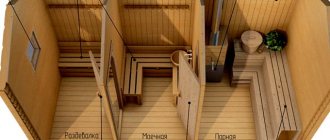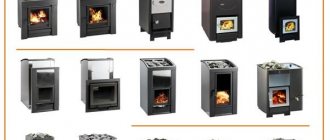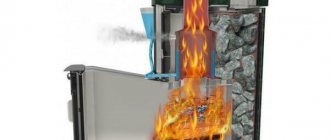Fans of relaxing in a bathhouse or sauna, having their own private house or summer cottage, will sooner or later think about building such a structure on their territory. After all, bath procedures provide an opportunity not only to have a good and fun time with friends, but also to relieve fatigue, improve health and simply relax. First of all, when building a bathhouse, you need to choose the type of stove. You can purchase it ready-made or create it yourself based on a step-by-step assembly algorithm, which will significantly save money.
When choosing ready-made electric stoves for a steam room, first of all, pay attention to the following:
- Optimal level of temperature and humidity;
- Structural integrity;
- Relative indicator of economic efficiency;
- Compliance with the interior of the sauna room.
- Maintaining the interior of the sauna/bath.
What is a heating element of a furnace?
By definition, a tubular electric heater (TEH) is an electric heating device in the form of a metal tube filled with a heat-conducting electrical insulator. Exactly through the center of the electrical insulator (heater core), a conductive nichrome thread of a certain resistance passes to transfer the required specific power to the surface. According to their configuration, heating elements are divided into double-ended (when the contact terminals are located on both sides) and single-ended - with contact terminals located on one side of the heater.
Benefits of an electric sauna
Before choosing a bath or sauna model, you should carefully study all the advantages and disadvantages in order to make the optimal decision.
The advantages of a sauna powered by an electrical network include:
- Simple principle of operation and features of the device.
- A compact space, such as an old storage room or a former barn, is ideal for equipping a home sauna.
- The electric steam room has a very narrow range of contraindications for use. For example, thermotherapy sessions are allowed for hypertension, during the recovery period after acute illnesses.
- The absence of saturated steam and high humidity prevents the development of pathogenic microorganisms, including fungi.
- The modern market offers a wide range of electrical installations and sauna stoves. In addition, you can make a simple oven with your own hands.
Beginners are presented with a large number of training videos, step-by-step instructions with detailed descriptions and high-quality illustrations.
How are heating elements used for saunas?
Any tubular electric heater is designed to heat and maintain a constant temperature in a liquid or gas by convection, conduction and radiation. Today, all electric sauna heaters use heating elements as heating elements! All manufacturers - Harvia, Helo, Sawo, Tylo, etc. – they produce their heaters both as part of the furnaces themselves and in the form of spare parts. Mainly, electric ovens use the property of convection: cold air is captured from below, releasing a hot stream upward. There are exceptions: thermos stoves and heaters, where heating elements are tightly lined with stones, use thermal conductivity, and, for example, TYLO models with open electric heaters actively use radiation from the elements for the fastest heating.
Main types of electric furnaces
- Classic steam room oven
is a massive device designed to heat liquids and stones. This category of stoves has a lot of weaknesses related mainly to ease of use. The brick structure must be installed on a special foundation. All safety and maintenance measures must be followed. Brick laying must be done by a professional stove maker. Firewood will be used as a fuel source. Classic stoves have a large heat capacity, so reaching operating temperature takes a lot of time. A brick stove must have ventilation holes and a chimney, which must be cleaned periodically.
- Metal furnaces
. This is not such a bulky type of oven as brick ones. Such stoves (potbelly stoves) are made from sheets of metal and their weight is much less than that of brick ones. Firewood is also used as fuel. But a special foundation for pouring is not required, which is also an advantage. It is enough to install a pedestal up to 20 centimeters high.
- Electric furnaces
Excellent for heating small baths and saunas. The installation takes up little space and does not require special care. Electric furnaces are also easy to operate. There is no need for a chimney. Heating is provided by tubular electric heaters - heating elements.
For electric heaters, you can use different types and configurations of heating elements. They must be characterized by reliability at high operating temperatures and high humidity. The outer shell of the heater must be made of stainless metal that is resistant to oxidation and moisture. The electric heater flange is secured by welding. Soldering is not suitable in this case. Tekhnonagrev produces heating elements for electric heaters of any complexity from high-quality materials.
What types of tubular electric heaters exist, and how do some differ from others?
There are a huge variety of tubular electric heaters; it makes no sense to talk about the entire classification. Electric heaters use double-ended heating elements with contact leads located on both sides. Heating elements of furnaces are divided into straight and oblique. For straight lines, the exits are directed downwards parallel to the turns of the spiral, and for oblique ones - to the side, perpendicular to the turns. Heating elements from different companies differ: in power, in length, in configuration, in fasteners, in the shape of the landing leads. You should always remember this when choosing replacement elements!
Why is it worth choosing an electric heater for a bath?
Electric heaters have a number of advantages and have proven themselves in practice. Let's consider each of the advantages of the heater separately:
- Room heats up pretty quickly
compared with other types of heating structures.
- Selected the temperature remains for a long time
.
- Due to the use of electric heaters as a heating source no need for a chimney
. For the same reason, ash and other deposits do not form inside the unit, which would have to be periodically cleaned. A ventilation system is also not needed.
- No special maintenance required either
. There is no need to clean out the soot. To operate, you only need an electrical outlet. Connect the network and select the desired temperature mode.
- It is easy to regulate the operation of the electric heater
. The thermostat is located inside the sauna room. The temperature can be constantly maintained or changed in a controlled manner throughout the entire process of using the bath. Fuses eliminate the risk of overheating.
- High level of operational safety
. The electric furnace does not produce carbon monoxide, which eliminates the risk of poisoning. Due to the absence of an open flame, ignition of wooden surfaces and elements of the bathhouse is impossible.
- Small dimensions
stoves allow it to be installed in small spaces. There is no point in installing a foundation. The use of a compact pedestal will be sufficient. For protection, lay out a brick partition.
Operating principle of an electric sauna
The principle of operation and arrangement of an electric sauna is not much different from a classic bath. The room is also lined with wooden slats and has shelves for resting. But the most important device in a sauna is the stove, which is closed with a protective casing.
An electric steam room will require constant access to a standard voltage network. When connected to the network, the stove heats jadeite or another type of element for the heating element. Stones at sufficient temperature, in turn, distribute heat throughout the room.
How to choose elements for heating elements
The most important elements for optimal performance of an electric sauna are the stove and the stones.
The choice of stones should also be given due attention, assessing them for compliance with the following characteristics:
- Ability to withstand ultra-high temperatures without splitting or cracking.
- Maximum possible service life.
- The shape of the stones affects the density of packing in the heating element.
Jadeite and volcanic peridotite fully meet all the requirements. The full list can be found on the pages of the catalog of products for saunas and baths.
Features of selection and operation
The future owner should not only choose the right stove, but also optimally use it in practice.
Features of the selection and operation of an electric sauna stove include:
- It is better to connect the purchased stove to a separate electrical power line. In this case, preference is given to wires with a large cross-section (at least 4 mm), which are protected from high temperatures. Immediately before connecting a new line to the meter, the wire is laid through a residual current device. The presence of such a detail will ensure the safety of house residents and sauna visitors.
- For maximum heating of the room, it may take from 0.5 to 3 hours, depending on the area of the room. In addition, this parameter is influenced by the power of the selected stove and its thermal insulation. Immediately upon reaching the optimal temperature, it is better to reduce the activity of the device by 1.5 times.
- When arranging an electric sauna, you should think through the ventilation system in advance. Lack of oxygen in the room can cause fainting, hypoxia, and poor health in the visitor. Excess oxygen will lead to increased energy consumption. The best solution would be to install ventilation gaps located under the door.
When choosing a particular oven model, you should pay attention to the following features:
- The presence of a protective housing or insulation that prevents burns to users. High-quality stoves are lined with tiles or stone.
- Availability of control panel. The best electric sauna stoves are equipped with a convenient control panel and an intuitive interface.
- Required network voltage. Most models are powered from ordinary 220 volt outlets.
Particular attention is paid to the material used to make the stove. The most commonly used are enameled steel, cast iron and stainless steel.
It is these materials that can withstand high heating temperatures without the formation of defects. An excellent example to choose from is the harvia electric sauna, which fully meets safety requirements.










